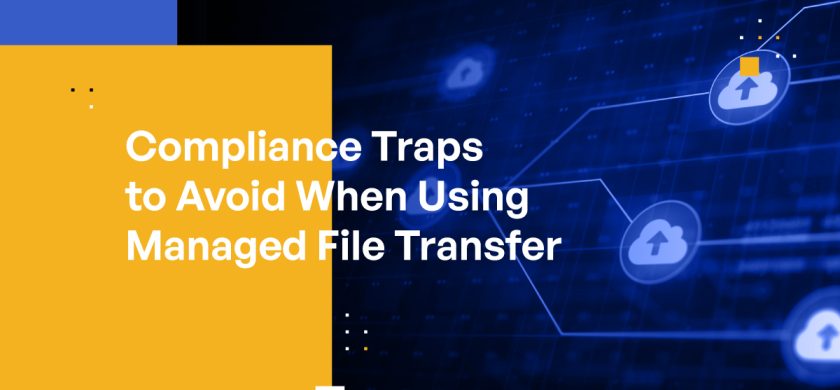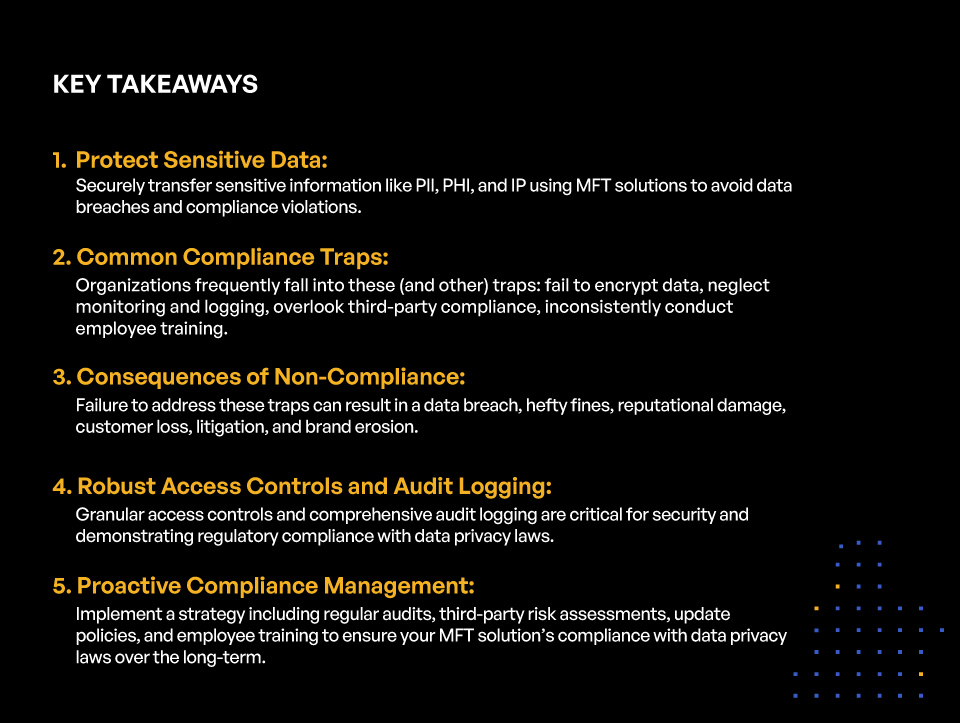
Compliance Traps to Avoid When Using Managed File Transfer
Managed File Transfer solutions are an essential part of modern business operations. These platforms facilitate the secure and efficient transfer of files between organizations, or within different departments of the same organization. They provide increased control and visibility over file sharing, offer enhanced security and improve compliance with various regulations.
While managed file transfer (MFT) solutions have a significant role in securing data transfers, misuse or misconfiguration can lead to data breaches and compliance violations. This can lead to an array of negative impacts such as, hefty fines, reputational damage, and loss of customers, all consequences businesses want to avoid at all costs.
Still debating between FTP and managed file transfer? Here are six reasons why managed file transfer is better than FTP .
In this guide, we will explore common regulatory compliance pitfalls that organizations can encounter when using managed file transfer solutions, and what organizations can do to avoid these traps.
PII, PHI, and Intellectual Property Protection
All organizations hold sensitive information that needs to be protected, particularly when it leaves the confines of the organization. Secure data transfer, and secure managed file transfer in particular, becomes paramount when organizations share sensitive information with trusted third parties like customers, consultants, and service providers.
Sensitive information frequently includes personally identifiable and protected health information (PII/PHI) like customer or employee names, addresses, and billing information. Sensitive information can also include intellectual property (intellectual property) like product specifications, financial information, and contracts. All of these are valuable assets and often the target of cybercriminals. In addition, employee or partner mishandling of this information could result in the violation of various regulations, such as GDPR, HIPAA, CMMC, ITAR, and many more.
Managed file transfer solutions, when used correctly, help protect these types of information by securing file transfers. Organizations that don’t take the necessary precautions when transferring PII, PHI, or IP, however, not only jeopardize exposing this information to unauthorized users but also violating compliance regulations that mandate data privacy.
What follows are just a few compliance traps organizations must avoid when using their managed file transfer solution for transferring sensitive information with trusted third parties.
Managed File Transfer Compliance Traps
There are numerous ways in which organizations can potentially violate compliance requirements when using managed file transfer systems. Violations can, once again, result in significant penalties, litigation, customer loss, and brand erosion. These traps may (or may not) be well known. Regardless, they must be avoided at all costs if an organization looks to avoid a compliance violation. Let’s take a closer look.
1. Failure to Encrypt Managed File Transfer Data
One of the key benefits of managed file transfer is the ability to encrypt data during transfer to ensure that it remains confidential and secure. Failing to properly encrypt sensitive data can leave it vulnerable to interception, potentially leading to data breaches and compliance violations. Organizations must ensure they are using up–to–date encryption methods, using appropriate encryption keys, and requiring encryption for all sensitive data transfers.
2. Lack of Controlled Access to Managed File Transfer Data
Controlling who has access to PII, PHI, and IP is critical for protecting sensitive information and maintaining compliance. Without proper access controls, unauthorized individuals may gain access to sensitive data, leading to potential data breaches. Modern, secure managed file transfer systems typically come with robust access control features that allow organizations to designate who can view, edit, or transfer certain files. Failing to effectively use these features, or not using them at all, can result in serious compliance issues.
3. Not Monitoring and Logging File Managed File Transfers
Monitoring and logging file transfers is crucial for both security and compliance. For security purposes, audit logs enable organizations to identify any unusual file transfer activities that may indicate a potential threat or breach. From a compliance perspective, audit logs provide a record of all file transfer activities, which can be necessary to demonstrate compliance in an audit.
KEY TAKEAWAYS

KEY TAKEAWAYS
- Protect Sensitive Data:
Securely transfer sensitive information like PII, PHI, and IP using MFT solutions to avoid data breaches and compliance violations. - Common Compliance Traps:
Organizations frequently fall into these (and other) traps: fail to encrypt data, neglect monitoring and logging, overlook third-party compliance, inconsistently conduct employee training. - Consequences of Non-Compliance:
Failure to address these traps can result in a data breach, hefty fines, reputational damage, customer loss, litigation, and brand erosion. - Robust Access Controls and Audit Logging:
Granular access controls and comprehensive audit logging are critical for security and demonstrating regulatory compliance with data privacy laws. - Proactive Compliance Management:
Implement a strategy including regular audits, third-party risk assessments, update policies, and employee training to ensure your MFT solution’s compliance with data privacy laws over the long-term.
Unfortunately, some organizations neglect this important feature of their managed file transfer solutions. Without monitoring and logging, it becomes almost impossible to detect and respond to any unauthorized or suspicious file transfers promptly. This can lead to a failure in spotting potential data breaches, thus leading to severe compliance violations.
4. Not Ensuring Third–Party Compliance
When using a managed file transfer system to transfer files with third parties like customers, consultants, contractors, it’s crucial to ensure that these trusted partners also comply with the same regulations that your organization does. Failure to ensure third–party compliance can lead to data breaches, compliance violations, and severe penalties.
Organizations must therefore thoroughly vet third parties before sharing sensitive data with them, carefully evaluating their security measures and compliance practices. Contracts should also include clear stipulations regarding data protection and compliance. These and other strategies are critical components of a third party risk management practice, something every organization should embrace.
5. Lack of Regular Managed File Transfer Solution Audits
Conducting regular system audits is an integral part of maintaining compliance. System audits provide an insight into the functioning of an organization’s managed file transfer solution, thereby enabling them to identify any potential weaknesses, gaps, or misuse. Failure to conduct regular audits can prevent the early detection of compliance issues, leading to potential breaches and violations.
Organizations should develop a system audit plan (not just for their managed file transfer solution, but all solutions) that outlines what will be audited, when, and by whom. This plan should also include the steps to be taken if a compliance issue is identified. Failure to implement and adhere to such a plan could potentially lead to serious compliance issues.
6. Not Updating or Patching Managed File Transfer Solutions
Just like any other solution, MFT solutions are subjected to constant threats by cybercriminals aiming to exploit vulnerabilities. Keeping your managed file transfer solution updated and patched is essential for maintaining a secure and compliant environment. Outdated solutions can have vulnerabilities that can be exploited by attackers and subsequently lead to a data breaches and compliance violation.
Organizations should have a software update and patch management policy in place to ensure that all solutions, including their managed file transfer solution, are always up to date. Ignoring system updates and patches not only puts an organization’s data at risk but also puts them at risk of non–compliance with regulations that require maintaining updated and secure systems.
7. Lack of Proper Training on Managed File Transfer Solutions
Another common trap that organizations fall into when it comes to maintaining compliance with managed file transfer solutions is the lack of proper training. Without thorough training, employees may not fully understand the importance of compliance or how to use the managed file transfer solution correctly. This could lead to inadvertent misuse or misconfiguration of the solution, resulting in potential compliance violations.
Regular training sessions should be conducted to keep employees aware of the latest compliance requirements, updates to the managed file transfer solution, and the correct procedures for secure and compliant file transfer. The training should also emphasize the repercussions of non–compliance to ensure employees understand the importance of their role in maintaining compliance.
Kiteworks Helps Organizations Avoid Compliance Pitfalls with Secure Managed File Transfer
Maintaining compliance when using managed file transfer is crucial in the compliance era. By understanding and avoiding common pitfalls, organizations can ensure they are efficiently using their managed file transfer solution while staying compliant.
Key points to remember include the importance of protecting PII, PHI and IP, conducting regular system audits, keeping the system updated, and ensuring third–party compliance. Additionally, securing data through encryption, maintaining controlled data access, and monitoring and logging file transfers are critical. Lastly, continuous employee training can help avoid potential breaches due to lack of awareness and misuse of the system.
By implementing and enforcing policies addressing these aspects, organizations can effectively avoid costly compliance traps and ensure secure and compliant file transfers with managed file transfer systems. This, in turn, will not only protect the organization from costly penalties and litigation but also help maintain customer trust and protect the organization’s reputation.
The Kiteworks Private Content Network, a FIPS 140-2 Level validated secure file sharing and file transfer platform, consolidates email, file sharing, web forms, SFTP and managed file transfer, so organizations control, protect, and track every file as it enters and exits the organization.
Kiteworks secure managed file transfer provides robust automation, reliable, scalable operations management, and simple, code-free forms and visual editing. It is designed with a focus on security, visibility, and compliance. In fact, Kiteworks handles all the logging, governance, and security requirements with centralized policy administration while a hardened virtual appliance protects data and metadata from malicious insiders and advanced persistent threats. As a result, businesses can transfer files securely while maintaining compliance with relevant regulations
Kiteworks secure managed file transfer supports flexible flows to transfer files between various types of data sources and destinations over a variety of protocols. In addition, the solution provides an array of authoring and management functions, including an Operations Web Console, drag-and-drop flow authoring, declarative custom operators, and the ability to run on schedule, event, file detection, or manually.
Finally, Kiteworks Secure MFT Client provides access to commonly-used repositories such as Kiteworks folders, SFTP Servers, FTPS, CIFS File Shares, OneDrive for Business, SharePoint Online, Box, Dropbox, and others.
In total, Kiteworks secure managed file transfer provides complete visibility, compliance, and control over IP, PII, PHI, and other sensitive content, utilizing state-of-the-art encryption, built-in audit trails, compliance reporting, and role-based policies.
To learn more about Kiteworks’ secure managed file transfer capabilities, schedule a custom demo today.
Additional Resources
- Blog Post 6 Reasons Why Managed File Transfer is Better than FTP
- Blog Post Secure Managed File Transfer: Which Solution is Best for Your Business?
- Video Kiteworks Secure Managed File Transfer: The Most Secure and Advanced Managed File Transfer Solution
- Blog Post Navigate Complex Financial Regulations With Secure Managed File Transfer
- Blog Post Eleven Requirements for Secure Managed File Transfer